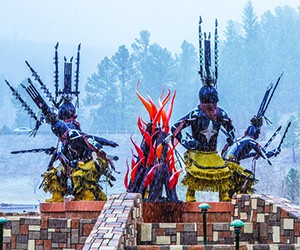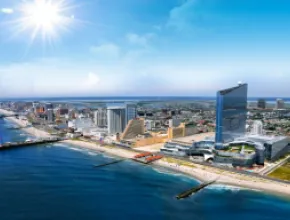In common with Australia, Canada and other lands inhabited by indigenous peoples since ancient times, the U.S. bears the lasting scar, or more accurately, unhealed wound, of the government-led colonization and lasting marginalization of Native Americans.
Tribes driven from their lands via the notorious 1830 Indian Removal Act (“The Trail of Tears”) would later suffer the unrestricted plundering of their cultural artifacts, gravesites and sacred objects by museums and other “collectors” through the egregious Antiquities Act of 1906 (partially remediated by the 1990 Native American Grave Protection and Repatriation Act).
Starting in the 1960s, one form of recovery for tribal communities was the crafting of museums into venues for preserving and teaching their history and traditions.
That trend has since reached Native American gaming resorts. While some tribes shy away from cultural showcases within gaming and leisure environments, others have embraced the opportunity to integrate their culture and heritage into areas including resort architecture and design, displays of native art, food and beverage, guided experiences, wellness, learning activities and service and hospitality.
Offering uniquely inspiring, spiritual and even transformative experiences for groups, Native American heritage and hospitality awaits at these leading Western casino-resorts and reservations.
The Wisdom of Trees
Opened as a casino in 1995 by the Pechanga Band of Luiseno Indians, Pechanga Resort and Casino is a major economic driver in California’s Temecula Valley and Inland Empire region.
“Starting out in temporary facilities with only 135 employees, our founding vision for the center was simple,” said Edith Atwood, president of the Pechanga Development Corporation and a Pechanga Tribal Member. “Namely, to create jobs for our community and to generate revenues for fundamental programs like reliable drinking water, basic healthcare, education and cultural protection.”
Adding a resort component in 2002, the AAA Four Diamond property, 90 miles from Los Angeles and 60 miles from San Diego, today employs more than 4,000 Californians and delivers $1.1 billion in total economic impact.
That contribution will only rise with the anticipated late 2017 completion of Pechanga’s $285 million expansion.
Adding a new 568-room hotel wing, two-story luxury spa, four-acre, resort-style pool complex, two new restaurants, 70,000 square feet of additional convention space—and nearly 1,000 additional jobs—the casino-resort, already California’s largest, will offer 1,090 new and renovated rooms, 100,000 square feet of indoor and 174,500 square feet of outdoor space, 13 restaurants and 13 pools. The project incorporates a complete rebranding, including a new logo.
Within this amenity-rich setting, which includes a 200,000-square-foot gaming floor, larger than any in Las Vegas, the Pechanga story comes vibrantly alive, as Atwood explained.
“The Temecula Valley has been home to my ancestors for over 10,000 years, since time immemorial,” she said. “While our reservation is currently less than 8,000 acres with under 2,000 members, we continue to grow, proud of having the largest Tribe since losing 90 percent of our population and territory land base during the dark days of the European colonization, Spanish Mission period and 1850s Gold Rush.”
In times of drought and scarcity, the Pechanga people relied on their oak trees for protein-rich “wi-wiish,” or crushed acorn meal.
“Symbolizing life in our culture, our oaks include the 1,500-plus year old ‘Wi’áasal,’ or Great Oak,” Atwood said. “We cherish this sacred tree, the largest indigenous coast live oak in the West, for representing the Tribe’s strength, wisdom, longevity, and determination.”
Exclusive visits to the Great Oak can be arranged, guided by Tribal cultural experts and including Pechanga history lessons. The tree is also celebrated in the three-story stained glass tower at the Pechanga Round Bar and in stained glass over the table games. Other cultural homages include woven baskets, clay pots and river images, with Kiicha huts (meaning “home”) and native flora adorning the property and Journey at Pechanga golf course.
Peak Performers
Groups arriving at Mescalero Apache Tribe-owned Inn of the Mountain Gods Resort and Casino in mountainous Mescalero, N.M., are greeted by a massive metal sculpture, “Mountain God Spirits,” or “Gehe,” in Apache, by the late Frederick Peso, grandson of an Apache chief.
Continuing the impressive welcome at the award-winning resort, which offers 273 luxurious guest rooms and suites, 40,000 square feet of technologically advanced convention space with theater-style seating for up to 3,000 delegates, championship golf, outdoor pursuits and more, is the Apache-art filled lobby. Setting the stage for inspiration, floor-to-ceiling windows provide panoramic views of the Tribe’s sacred mountain, Sierra Blanca Peak, and Lake Mescalero.
Consisting of the Mescalero, Lipan and Chiricahua sub-tribes, the once nomadic Mescalero Apache Tribe today resides on a 463,000-acre reservation in the heartland of its aboriginal homelands, with other enterprises including Ski Apache Ski Resort.
Featuring tribal-inspired contemporary accents of turquoise, blue and green in the guest rooms, tribal influences extend to dining establishments such as Wendell’s Lounge, named for Wendell Chino, the longtime Mescalero Apache Nation president who helped lift the tribe from poverty.
Another mountain-backed retreat beckons some 25 miles north of Albuquerque International Airport at the Pueblo of Santa Ana’s luxurious Hyatt Regency Tamaya Resort and Spa. With 350 pueblo-style guest rooms, the 500-acre property offers 29,000 square feet of indoor space and 25,000 square feet of outdoor space. With views of the surrounding cottonwood forest and Sandia Mountains, venues include the House of the Hummingbird, its spacious lawn enclosed by replica ancient pueblo ruins.
Originally the Tamayame, the Santa Ana people have lived in New Mexico since at least the 1500s. Assigned the patron saint of Saint Anne and renamed as Santa Ana during Spanish rule in 1598, the tribe settled in the fertile Rio Grande Valley. Today, 800-plus tribal members live on the 79,000-acre Tamaya Indian Reservation, many speaking the tribe’s original Keresan language.
The Santa Ana Pueblo created the partnership with Hyatt as an immersive showcase of their ancient culture and traditions. The tribe-led “Srai Wi” cultural program includes bread baking in a huruna oven, adobe brick making, jewelry-making classes with a Navajo silversmith, and tours of the onsite Tamaya Cultural Learning Center, which features a full retrospective of the tribe’s history.
Paintings, photography, pottery and other works from renowned Native American artists adorn the property, where guests are greeted by a large bronze statue representing traditional Tamayame principles of welcome.
Honoring the Pueblo’s oral history tradition, the resort also features renowned Native American storyteller Emmitt Garcia. Other unique experiences include traditional dance and flute performances, exploring petroglyphs on horseback, and golfing through 20 ancient cultural sites.
Incorporating local spices, oils and mud, Native American-inspired treatments at the resort’s Tamaya Mist Spa include “Ancient Drumming” and “Spirit Path.”
PageBreak
Transformative Times
Back in California, the Santa Ynez Band of Chumash Indians, located on the Santa Ynez Reservation in Santa Barbara County’s wine region, remain the nation’s only federally recognized (1901) Chumash tribe. Since opening in 1994, the Chumash Casino Resort has evolved through enhancements including last year’s addition of a 135-foot hotel tower overlooking the Santa Ynez Valley. The resort offers 320 luxurious rooms and 58 suites, with flexible event spaces for groups of up to 800.
The tribe, also operating boutique Hotel Corque in nearby Solvang, incorporates Chumash principles, practices and traditions into the guest experience.
“Perhaps the best example are the six bronze sculptures that grace the vestibule,” explained Veronica Sandoval, whose public relations responsibilities include administrating the Chumash Foundation, through which the tribe has donated more than $20 million to local nonprofit community organizations.
Commissioned by the tribe, Sandoval said the statues of Heritage, Tradition, Generations, Provision, Celebration and Flames of Victory pay tribute to the tribe’s ancestral way of life and story of perseverance, survival and adaptability.
“The vestibule is a center of welcome for learning about the Chumash people—and a place to remember, reflect and celebrate,” she said.
Inhabiting the Santa Ynez Valley for 8,000 years, the Chumash hold a special responsibility to provide restorative hospitality to guests, Sandoval added, transforming them so they can leave ready to face the challenges of their journey.
Owned by the Pala Band of Mission Indians, the AAA Four Diamond Pala Casino Spa and Resort in northern San Diego County offers 507 guest rooms, including 82 suites, and 40,000 square feet of flexible convention space. In 2016, Spas of America named the resort’s spa third best in North America, and No. 1 in both California and among all U.S. casinos. Other draws include scenic Palomar Mountain views and diverse venues such as the 2,037-seat Pala Events Center and underground wine cave.
Located on a 12,273-acre reservation, the Pala story is unique in the annals of forced Indian relocation. As described on the tribe’s website, in 1903, President Rutherford Hayes, prompted by a Supreme Court ruling, ordered the tiny Cupeno Indian tribe removed from their ancestral land. Enduring their own 40-mile “Trail of Tears,” the tribe resettled with the Pala, then a Luiseno Indian reservation, “marking the first time in U.S. history that two distinct Indian tribes were herded together in one reservation.” Living in harmony as one ever since, the Pala invites visitors to their annual on-reservation “Honoring Traditions” Powwow, celebrating 10 years this August.
Evergreen Appeal
Located 40 miles north of Seattle, the 370-room AAA Four Diamond Tulalip Resort Casino, offering more than 30,000 square feet of flexible group space, maintains its place as one of Washington’s premier destinations through regular enhancement projects. Commenced in early 2016 and targeting completion this spring, the latest effort, a $15 million renovation, includes a comprehensive guest room redesign.
From the 25-foot house posts carved from a 1,000-year-old cedar that greet arriving guests to the fresh Northwest seafood prepared using traditional tribal techniques at the Blackfish Wild Salmon Grill and Bar, the resort reflects the land- and water-based legacy of the Tulalip Tribes. As the federally recognized successors in interest to the Snohomish, Snoqualmie and Skykomish tribes and other tribes and bands signatory to the 1855 Treaty of Point Elliott, half of Tulalip’s 4,300-plus members live on the 22,000-acre Tulalip Indian Reservation.
Opened in 2011 as Washington’s first state-certified tribal facility, the event-ready Hibulb Cultural Center and Natural History Preserve presents Tulalip history, cultural values and spiritual beliefs.
Its homeland once spanning 5 million acres across Washington, Montana and Idaho, the ancient Coeur d’Alene Tribe of Indians (French for “Heart of the Awl,” referring to the tribe’s trading skills, and in the native language, Schitsu’umsh, meaning “Those who were found here” or “The discovered people”) infuses its reverence for natural law and environmental stewardship throughout the 300-room Coeur d’Alene Casino Resort Hotel in northern Idaho.
With versatile group space and amenities including a luxury spa and top-ranked golf course, tribal references abound, from indigenous flavors in the resort’s seven dining establishments to artistic and ancestral depictions throughout. Groups can also participate in cultural events throughout the year, including powwows, stickgame tournaments, and a ceremonial winter blessing.







